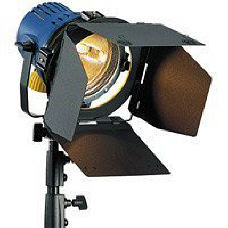
Above- Popular with professional photographers; The Tungsten light.

Above- A standard camera flash.
Considering lighting when taking photographs of people.
Front lighting reveals every detail of the subject (depending on the exposure). To get a mystifying effect, lighting from the side is always a good idea. The main illumination from the sides adds interest and dark shadows. In Back lighting, the light source remains at the back of the subject shining into the lense of the camera. When using this lighting method, it is essential to be careful as the subject may appear like a silhouette. However, this method is an advantage for shooting outdoors as the light will not make the model squint their eyes making it easier to capture their facial expressions etc. Cross lighting is also achievable but really is only suitable in a photographic studio with Tungsten lights or a bright flash.
Digital Camera Modes.
Most digital cameras have a wide range of lighting modes to suit certain scenarios. For example, the indoor mode to click without a flash. This could be useful in places such as art galleries and museums. Also the portrait and night mode which allow you to take photographs of your subject with a light backdrop using a slow shutter speed. Most digital cameras also provide a built in setting which controls your white balance aswell as a histogram to examine exposure in different conditions.
Using Light.
Basically, light is made up of all colours. If you look through a glass prism, it bursts into all different colours. Artificial lights have their own characteristics, and the photographer can utilize different light sources for different effects. But the direction of light has to be one of the most important aspects you need to consider when taking images. People look their best in side lighting and backlighting, as this produces a halo effect while overhead lighting produces a very sharp contrast of light and shadows. Another essensial factor is the strength of the lighting too. You can achieve a placid effect from diffused lighting and a and a sharpness from a stronger light. When indoors, daylight can soften your images, but artificial lighting also gives a broad scope to shoot pictures. When outdoors, getting the right lighting is more challenging. Different things need different light to bring out the best aspects of the particular object/scene you may be photographing. For example, Landscapes are better in softer lighting. Artificial light is measured in Kilowatts. Candle light is very low at 1000K, where as a standard household bulb is around 3200K. A tip for people who are taking photographs when the light is above the subject is for them to look upwards so that a pool of light is deposited across their face.
Studio task.
We took a series of photographs of a fellow student experimenting with natural lighting.
The settings on my camera were as follows;
F 5.6
ISO 400
Shutter Speed 125
Image 1. Light source; Daylight, coming from George's right hand side through the window. Quite a soft focus.
Image 2. George facing the natural light. The result of the image; Not as subjude as the first. Directional but still a soft focus.
Image 3. George facing away from the natural light. Shutter speed decreased on camera to let in more light.
Image 4. George is in the same position but there is a higher exposure/extra stop of light (ISO).
(Images coming soon).






 The compositions are all very central in his images. Another thing I have noticed is that he tends to take the majority of his photographs outdoors.
The compositions are all very central in his images. Another thing I have noticed is that he tends to take the majority of his photographs outdoors. Above; Andy adjusting the set.
Above; Andy adjusting the set. Above; The general setup used for this shoot.
Above; The general setup used for this shoot.





